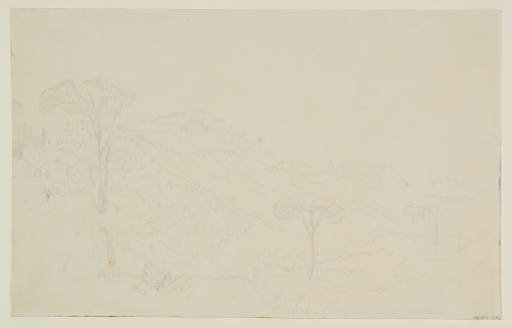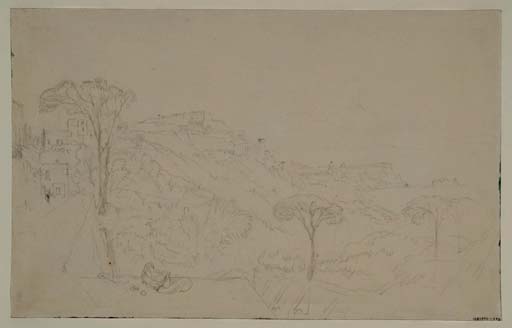Joseph Mallord William Turner Naples and Vesuvius from the Posillipo Hill near Virgil's Tomb 1819
Image 1 of 2
Joseph Mallord William Turner,
Naples and Vesuvius from the Posillipo Hill near Virgil's Tomb
1819
Joseph Mallord William Turner 1775–1851
Naples and Vesuvius from the Posillipo Hill near Virgil’s Tomb 1819
D16102
Turner Bequest CLXXXVII 14
Turner Bequest CLXXXVII 14
Pencil and traces of watercolour on white wove paper, 255 x 404 mm
Inscribed by John Ruskin in blue ink ‘14’ bottom right, descending right-hand edge
Stamped in black ‘CLXXXVII 14’ bottom right
Inscribed by John Ruskin in blue ink ‘14’ bottom right, descending right-hand edge
Stamped in black ‘CLXXXVII 14’ bottom right
Accepted by the nation as part of the Turner Bequest 1856
Exhibition history
1904
[Associated with Third Loan Collection], possibly introduced as replacement items at Royal College of Art, London, between 1904–1909.
1992
Turner as Professor: The Artist and Linear Perspective, Tate Gallery, London, October 1992–January 1993 (103, reproduced).
References
1909
A.J. Finberg, A Complete Inventory of the Drawings of the Turner Bequest, London 1909, vol.I, p.555, as ‘Naples, with Vesuvius. Third Loan Collection, No.47’.
1991
Ian Warrell, ‘R.N. Wornum and the First Three Loan Collections: A History of the Early Display of the Turner Bequest Outside London’, Turner Studies, vol.11, no.1, Summer 1991, p.49, no.47.
1992
Maurice Davies, Turner as Professor: The Artist and Linear Perspective, exhibition catalogue, Tate Gallery, London 1992, p.80, reproduced, as ‘Naples with Vesuvius’.
One of the most famous panoramic views of the Bay of Naples is that from the Posillipo Hill to the west, and like many English tourists, Turner made the ascent of the hill to the so-called Tomb of Virgil above the opening of the Grotto of Posillipo (now known as the Crypta Neapolitana in present-day Parco Vergiliano) and his viewpoint for this drawing appears to be a walled terrace very near the tomb. The vista looks east across the semi-circular sweep of the Chiaia waterfront towards the headland of Castel dell’Ovo with Vesuvius rising beyond. Above the city to the left are the Castel Sant’Elmo and the Certosa di San Martino, whilst the building along the ridge of the Vomero Hill just in front of Sant’Elmo is the seventeenth-century Villa Belvedere. Visible in the bottom right-hand foreground are the buttresses of the winding zigzag road, the Salita di Sant’Antonio (present-day Rampe Sant’Antonio), by which people made the ascent from Piedigrotta and Mergellina to the Church of Sant’Antonio and Virgil’s tomb. Related compositions can be found on folio 55 (D16143), as well as in the Gandolfo to Naples sketchbook (Tate D15664–15666; Turner Bequest CLXXXIV 54–55) and the Pompeii, Amalfi, Sorrento, Herculaneum sketchbook (Tate D15904; Turner Bequest CLXXXV 90). Compare also a drawing by James Hakewill (1778–1843), Naples and Mount Vesuvius from above Virgil’s Tomb 1816 (British School at Rome Library), reproduced in Hakewill’s Picturesque Tour of Italy (published 1820), a book to which Turner also contributed illustrations.1
Maurice Davis has cited the inclusion of the foreground terrace as an example of Turner’s tendency to position the viewer very close to the pictorial surface of the composition.2 This device of indicating the ‘viewing stage’ through perspective ensures the participation of the spectator within the construct of the scene.3
Technical notes:
Long detached from the Naples, Rome C. Studies sketchbook, this sheet was perhaps once folio 14 (see the concordance in the introduction). As Ian Warrell has established, the drawing is one of a number of items associated with the Third Loan Collection, a group of Turner Bequest works exhibited in the provinces during the late nineteenth and early twentieth centuries.1 Many of the loans suffered fading and damage from the effects of over-exposure during this time and this drawing seems to have been part of a replacement selection introduced between 1904 and 1909.2 Evidence of the discoloration of the paper is visible around the edges where the sheet has previously been displayed within a mount.
Verso:
Blank
Nicola Moorby
November 2010
How to cite
Nicola Moorby, ‘Naples and Vesuvius from the Posillipo Hill near Virgil’s Tomb 1819 by Joseph Mallord William Turner’, catalogue entry, November 2010, in David Blayney Brown (ed.), J.M.W. Turner: Sketchbooks, Drawings and Watercolours, Tate Research Publication, December 2012, https://www


